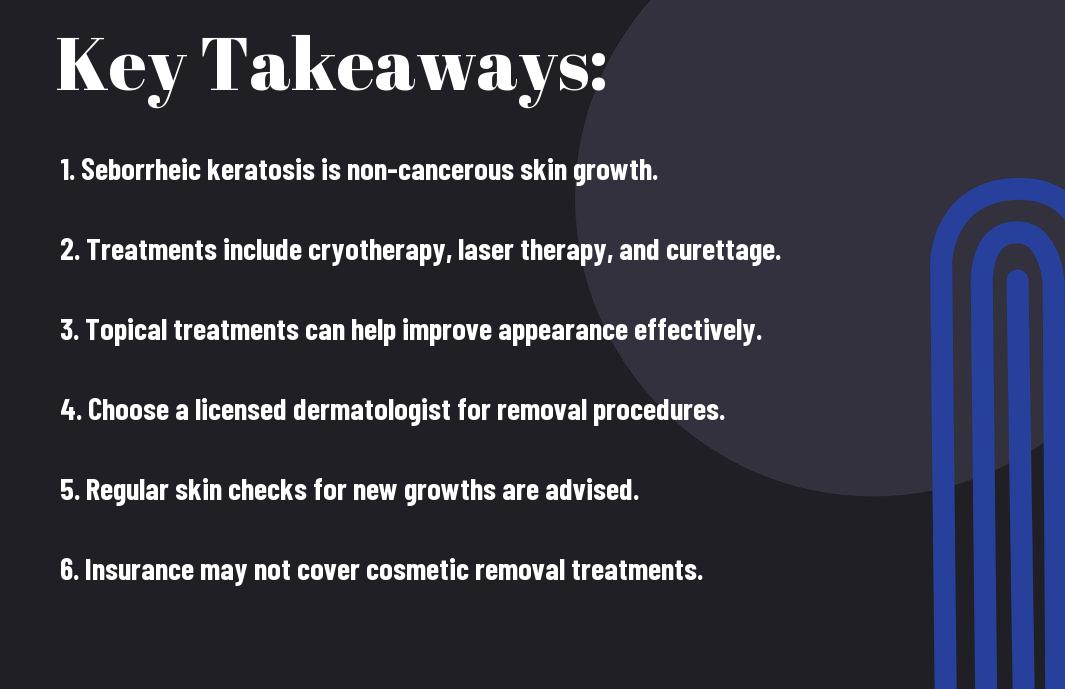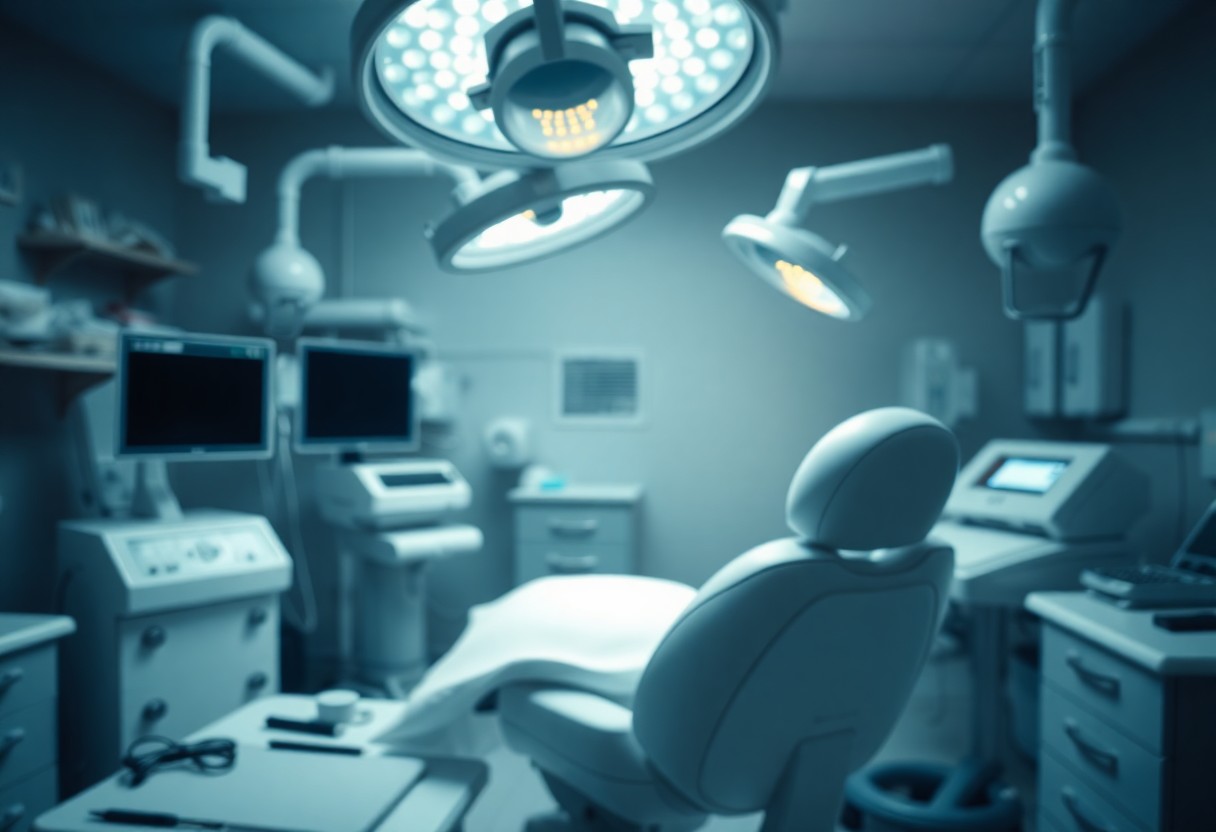Seborrheic keratosis can often be a source of concern, particularly if you have noticeable growths on your skin. Understanding the best treatment options available is crucial for effectively managing and removing these benign lesions. In this blog post, you will explore various methods for seborrheic keratosis removal, including both professional treatments and at-home care strategies, empowering you to make informed decisions for your skin health.

Understanding Seborrheic Keratosis
As you explore the world of skin conditions, you may come across seborrheic keratosis, a common, benign skin growth that can appear in various shapes and colors. While it is usually harmless, understanding its nature can help you manage any concerns about its appearance or potential removal options.
What is Seborrheic Keratosis?
For those unfamiliar, seborrheic keratosis is a non-cancerous skin tumor that appears as a raised, scaly, and often itchy growth on the skin. They can vary in color from light tan to black and are generally painless, but their texture and size can vary widely.
Causes and Risk Factors
Below are some common causes and risk factors associated with seborrheic keratosis:
- Age - more likely to occur in older adults
- Genetics - a family history may increase your risk
- Sun exposure - prolonged UV exposure may contribute
- Other skin conditions - certain skin disorders correlate with higher occurrences
Assume that maintaining your skin health may play a part in reducing your risk.
With a better understanding of the causes, it’s important to note that seborrheic keratosis can develop due to various factors. These include the natural aging process, where skin grows and thickens over time. Additionally, genetic predispositions may make you more susceptible, as these growths can run in families. Awareness of your sun exposure and other skin conditions may also be beneficial in monitoring any changes in your skin.
- Environmental factors - irritants or skin trauma
- Immunosuppression - conditions that weaken the immune system may lead to more growths
- Hormonal changes - fluctuations may influence your skin’s appearance
Assume that proactive care can help you manage your skin’s health effectively.
Signs and Symptoms
Even though seborrheic keratosis is not harmful, it can present noticeable signs that may concern you. Typically, they appear as raised, waxy, or scaly patches on your skin, often colored brown, black, or tan. You may notice that they vary in size, sometimes growing to several centimeters. These growths are usually asymptomatic, but they can become itchy or irritated, especially if they rub against clothing or are scratched.
Identifying Seborrheic Keratosis
The most recognizable feature of seborrheic keratosis is its distinct appearance. You may see flat or raised growths that have a rough, scaly texture. These lesions often have a "stuck-on" look and can vary in color from light tan to dark black. They are often found on the face, chest, shoulders, or back, and are generally asymptomatic, though they can itch on occasion.
Differentiating from Other Skin Conditions
Differentiating seborrheic keratosis from other skin conditions can be challenging due to similarities in appearance. You may encounter conditions like moles, warts, or skin cancers that look like seborrheic keratosis, making a proper diagnosis necessary. Always consult a dermatologist if you have any doubts.
But understanding the differences can aid in reassuring you. While seborrheic keratosis is benign, other skin growths such as melanoma or basal cell carcinoma can pose serious health risks. Moles tend to be uniform in color and shape, while warts may feel bumpy and are often caused by the HPV virus. If you notice any changes in size, shape, color, or experience bleeding, it's important to seek medical advice to ensure proper evaluation and treatment.

Treatment Options
Despite the various options available, the right treatment for seborrheic keratosis will depend on your specific needs and skin type. Recent studies highlight the successful use of picosecond laser treatment for skin lesions, which has become a popular choice among patients seeking effective solutions. Other methods include cryotherapy, curettage, and chemical peels, all of which help remove or reduce the appearance of these growths.
At-Home Remedies
AtHome treatments for seborrheic keratosis can provide relief and assist in managing the condition. Ingredients such as apple cider vinegar and tea tree oil may help reduce irritation and inflammation. However, it’s crucial to consult with a dermatologist before attempting any home remedies to ensure their safety and effectiveness for your skin type.
Medical Procedures
An effective approach to treating seborrheic keratosis often involves medical procedures, particularly for those with multiple or larger growths. Techniques like cryotherapy involve freezing the lesions using liquid nitrogen, while curettage entails scraping them off gently. Additionally, laser therapies, including the use of picosecond lasers, offer a minimally invasive way to achieve desirable results, often with reduced recovery time.
A dermatologist will evaluate your specific case to recommend the most suitable medical procedure. Each method has varying effectiveness and recovery times, so it's important to discuss these options in-depth. Many patients find that professional treatments significantly improve the appearance of their skin, restoring confidence and comfort.
Surgical and Non-Surgical Treatments
After exploring your options for seborrheic keratosis removal, you may find that both surgical and non-surgical treatments can effectively eliminate these growths. If you're wondering what are some treatment options for seborrheic keratosis?, you’ll be pleased to know that you have several choices to consider, depending on your specific needs and preferences.
Cryotherapy
Beside other options, cryotherapy is a popular non-surgical method that uses extreme cold to freeze off seborrheic keratosis lesions. You may find this treatment effective and quick, with minimal downtime for recovery.
Electrosurgery
By opting for electrosurgery, you can have seborrheic keratosis removed using a high-frequency electric current. This technique not only eliminates the growth but also helps minimize bleeding during the procedure.
Cryotherapy involves applying liquid nitrogen to the affected area, which destroys the keratosis cells. This procedure is usually painless and has a short recovery time, making it an attractive option. You may experience some redness or swelling immediately after treatment, but these symptoms typically resolve quickly.
Aftercare and Recovery
Once again, prioritizing aftercare is important for optimal recovery following seborrheic keratosis removal. Your skin may experience tenderness, redness, or slight swelling, which usually subsides within a few days. Keeping the area clean and moisturized will promote healing. Avoiding sun exposure and refraining from picking at the site will help minimize complications and ensure a smooth recovery process.
Post-Treatment Instructions
Before you leave your treatment appointment, it’s important to follow any specific instructions given by your healthcare provider. Typically, you should avoid strenuous activities, keep the area dry, and apply any recommended ointments or dressings. Staying hydrated and eating well can also support your skin's healing process.
Potential Side Effects
Between the common side effects you may experience are redness, swelling, and minor discomfort at the treatment site. These symptoms usually resolve within a few days, but it's important to monitor your skin for any unusual changes that could indicate complications.
A small risk of side effects exists after seborrheic keratosis removal, including infection, scarring, or changes in skin color. While most individuals heal without issue, it's wise to consult your healthcare provider if you notice increasing redness, pus, or persistent pain. Discussing these potential side effects with your provider beforehand can help you navigate your post-treatment experience confidently.
Preventive Measures
Your commitment to preventive measures can significantly reduce the chances of developing seborrheic keratosis. Regularly protecting your skin from excessive sun exposure, adhering to a balanced skincare regimen, and maintaining a healthy lifestyle will contribute to overall skin health. Additionally, being observant of any skin changes and consulting a dermatologist when necessary will help catch any concerns early on, enabling you to take appropriate action.
Skin Care Routine
Among the best strategies to prevent seborrheic keratosis is to establish a consistent skincare routine. This should include gentle cleansing, moisturizing, and the use of sunscreen with a high SPF. Avoiding harsh soaps and chemicals will help maintain your skin’s natural barrier, while regular exfoliation can prevent the buildup of dead skin cells that contribute to abnormal growths.
Regular Dermatological Check-ups
Above all, scheduling regular dermatological check-ups is crucial for monitoring your skin's health. These visits provide an opportunity for early detection of any potential issues, including seborrheic keratosis. Your dermatologist can assess your skin and offer tailored advice, ensuring any changes are addressed promptly. Consistent evaluations can help manage any existing conditions and contribute significantly to your long-term skin health.
Dermatological check-ups not only allow for the detection of seborrheic keratosis but also provide a comprehensive assessment of your skin's overall health. During these appointments, you can discuss any new lesions or changes to existing spots, which can assist in determining the right treatment plan if necessary. Additionally, your dermatologist may recommend preventive measures specific to your skin type, lifestyle, and family history, ultimately empowering you to maintain healthier skin.
Summing up
Ultimately, when considering seborrheic keratosis removal, it's vital to explore the best treatment options available for your unique situation. You may find that options such as cryotherapy, curettage, or laser therapy are effective methods for eliminating these benign growths. Always consult with your dermatologist to determine the most suitable approach for your skin type and condition. By taking proactive steps, you can achieve smoother, clearer skin and enhance your overall confidence.
FAQ
Q: What are the most popular methods for removing seborrheic keratosis?
A: There are several effective methods for removing seborrheic keratosis, including cryotherapy, which uses liquid nitrogen to freeze the growths; curettage, where a dermatologist scrapes the growth off the skin; laser therapy, which targets and destroys the keratosis with focused light; and electrosurgery, which uses electrical currents to remove the growth. Each method has its own advantages and is chosen based on the size and location of the keratosis, as well as the patient's skin type and preferences.
Q: How do I know if I should seek treatment for seborrheic keratosis?
A: Treatment for seborrheic keratosis is often considered if the growths become bothersome, itchy, or irritated, or if they change in appearance. If you are unsure, it is best to consult with a dermatologist who can evaluate the growths and recommend appropriate treatment based on individual circumstances. Regular self-examinations and monitoring any changes in the keratosis can also help in making this decision.
Q: Is seborrheic keratosis removal covered by insurance?
A: Coverage for seborrheic keratosis removal can vary depending on the insurance policy and the specific circumstances. Procedures considered medically necessary, such as those that address symptoms or changes in appearance, may be covered. However, purely cosmetic removals may not be included. It is advisable to check with your insurance provider to understand your coverage and any potential out-of-pocket expenses.
Q: What can I expect during and after the seborrheic keratosis removal procedure?
A: During a seborrheic keratosis removal procedure, patients may receive a local anesthetic to minimize discomfort. The procedure itself typically takes only a few minutes, depending on the size and number of growths being removed. After treatment, some patients may experience mild swelling, redness, or a scab at the treatment site, which usually resolves within a few days to weeks. Following post-care instructions from your dermatologist is important to ensure proper healing and to avoid complications.
Q: Are there any risks or side effects associated with seborrheic keratosis removal?
A: Like any medical procedure, seborrheic keratosis removal can come with some risks and side effects. Possible complications include bleeding, infection, scarring, or pigmentation changes in the treated area. However, these are generally uncommon, especially when performed by a qualified dermatologist. Discussing potential risks with your healthcare provider before the procedure can help you make an informed decision.







0 Comments